|
|
E-Village News
Responding to the Call of the Ancestors February 2011
|
|
Greetings!
This February 2011 issue of E-Village News is based on a reflection---those of us who participated in the wondrous Beyi Ritual in October 2010, listened intently as Malidoma proclaimed:
We need more prayers, we need more poetry, we need more stories, we need more song! I don't know how to teach people to become mythologically aware! We need to stop using mundane English to talk to each other. If there's something about you that makes me uncomfortable, I'll come and read you a poem, and that will settle that! Maybe together we can go out and sing a song to the trees...
In response to his exhortation, I have felt an insistent urge from Spirit and the Ancestors to feature a newsletter on storytelling: myths, fables, folktales, legends, etc. 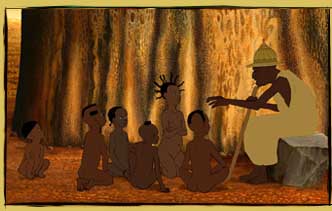 | Storytelling Scene from the African folktale
"Kirikou & the Sorceress"
|
Malidoma pointed out that "One of the biggest problems we are facing in modern days is that we are constantly distancing ourselves from mythology. As a result, we are entering into an ever-increasing mundaneness. We lose contact with the mystical and the esoteric to the point where the word myth is borderline connected with something that is not true. A person who awakens to spirit must take offense to that! We've been de-mythologized! We've been taken out of the wonderland that this existence should imply. And we make a big effort to make sure as quickly as possible that our children catch up with the reality of the mundaneness of this existence." In addition, Malidoma asserted, "It seems as if what we are facing is a big task of undoing the kind of mind job that was done upon us. The invitation for re-embracing mythology simply means allowing what we refer to as the 'Other World' to freely walk in and out of this world---and by doing that, we make it possible for the magical, the supernatural in us to wake up!" 
Malidoma writes in his book, Of Water and the Spirit, "When I was little, two people in my family fascinated me: my mother and my grandfather." Featured here in this issue, are two Dagara stories: the first is told to Malidoma by his mother, and the second is told to him by his grandfather. Also featured is an article, Mythology and Dagara Cosmology, by Glenn Leisching, who was recently initiated during the 2009 Elder Initiations held at East Coast Village in Cherry Plains, New York. Malidoma further illustrates the importance of myth and storytelling stating, "But in the traditional view, to look to the old ways is to avoid death. The argument is that our ancestors lived thousands of years under conditions that today would be considered extremely harsh and unbearable. In honor of their wisdom, we feel a sacred approach to, and reverence for, tradition even when its dictates are not fully understood. The origin of and the need for myth are rooted in this because it provides a worldview, a series of customs that are useful in defining the identity of a society. People don't read the Brothers Grimm, the Arabian Nights, or the Nibelungen in order to collect evidence of how backward or irrelevant these stories are to the present. They read them because these stories feed something deep in them . . . ." ( The Healing Wisdom of Africa, pgs. 124-125) We hope you will be fed and inspired while enjoying the material presented in this issue. Peace & Blessings! Yetunde P.S. To learn more about the Beyi Ritual, see our August or September 2010 newsletter from the newsletter archives on our website! |
|
|
The Story of Kula and Woor
| 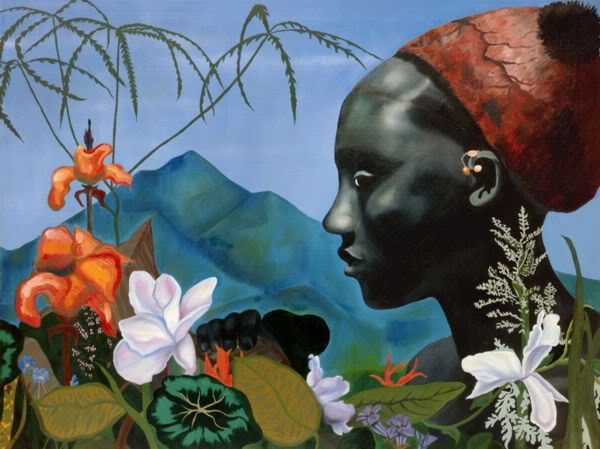 ....Until I was three years old my mother would carry me tied onto her back whenever she went in search of wood or grain or simply to farm. I loved to be knitted so closely to her, to watch her collect wood and carry it home on her head singing. She loved music and perceived nature as a song. While walking any great distance, she always sang to me. The story was always chosen to match the length of the journey, and was usually about some unfortunate girl or woman, usually an orphan. One I remember in particular was about a girl named Kula, whose mother died and left her with a little sister Naab, to take to their aunt. Kula asked Woor, her slave, to do the packing while she dressed herself as a queen, putting on gold necklaces, rings, and beads for
the journey. Woor, who was more practical than her unmindful mistress, packed a lot of water along with her personal things. On the road Naab, the little sister that Kula carried on her back, felt thirsty and asked for water. The only person who had brought any water was Woor, but she wasn't about to give it away for free. In payment, she asked for a gold ring. The day was terribly hot and dusty, and a little while later, Naab cried again for water. Kula again begged Woor, this time trading her gold earrings for the water. This went on and on until the slave girl was dressed up like a queen, and Kula, stripped of her finery, looked like a slave. The next time Naab cried out for water, her sister had nothing left to trade. Woor suggested that she herself carry the child. Thus, the three girls arrived at the house of the aunt, who welcomed them, mistaking the slave girl for her niece and the niece for the slave girl, and thus their identities were reversed. The slave girl was treated well and kept in the warm comfort of home, while the niece was treated as a slave and sent out to the farm to guard the crops against wild creatures. As the days went on, the queen-become-slave sang the story of her life to scare the birds and animals away from the crops. A singing human voice in the middle of a farm always keeps the intruder away. As Kula cried out her plight, her tremulous melody touched the hearts of the winged and the four-legged creatures alike. One day the Kontombili, the spirits who live in the underworld, were passing by and heard Kula's song. They stopped and listened carefully as her mournful voice rose and fell amid the tall, end-of-rainy-season grass. When she stopped to catch her breath the Kontombili approached her and asked her to sing her song again. After she had finished, they asked, "Is this story true?" And she said, "I only sing what I know." The Kontombili said, "Go home, little lady. Your troubles are over. Your aunt's eyes will be opened and she will know who you are." Kula went home and, as the Kontombili had promised, the aunt recognized her at once as her true niece. She was given her beautiful clothes and jewels back and placed in the bedroom where Woor the usurper had been sleeping. But Kula had learned true humility during her time as a slave, and she did not wish to switch from such hardship to immense luxury and comfort. She asked if she could continue to stay in the slave girl's room and be given the leftovers from the rich folk's meals. Dumbfounded, sorry, and confused, her aunt could only keep apologizing for having treated her so badly. Meanwhile the real slave girl was sent out to the farm to guard it against the creatures of the wild. She could not sing, so she sat and made raucous noises when birds landed on the crops. Along came a different group of Kontombili who had been told of the farm girl and her beautiful singing. They begged her for some music, saying, "We heard that your voice brings tears to the heart. Please let us hear that song you sing everyday." Unaware who she was speaking to, Woor replied rudely, "What are you talking about? I ain't got no song to sing to nobody." Then she barked harshly, thinking that would scare these beings away. To the sensitive ears of Kontombili this sound was like the smell of vomit. Disgusted and puzzled, the Kontombili asked Woor once more for a real song. Answering their courtesy with rudeness, the girl rebuked them in the same way. Believing they had been deceived by the girl, the Kontombili grew so angry that they turned her to stone. I never liked the ending to my mother's stories. Someone always became something or someone else. When a story threatened to end before our journey did, she expertly extended it. I heard the story of Kula and Woor many times, but each time something different happened. Sometimes my mother would depict Kula's life with greater misery, as if she guessed that I did not like the fact that the usurper was turned to stone and, therefore, waned to make a better case for her punishment. One time she had the little queen eat not just crumbs from the table, but had her share her meals with the dog. "But Mom," I protested, "she didn't do that the other day. She ate only the leftovers." "Yes," answered my mother, "but if she eats what the dog eats, then she can all the more enjoy returning to her queenhood, and you can enjoy watching the slave die." Of Water and The Spirit pgs. 15-16 _____________________________________________ _____________________________________________ REFLECTION: As the narrative ends, people have either seen themselves as the slave girl, the queen, or the little sister. Some people may even have identified with the kontombli. If someone identifies with the slave girl, the indigenous would say that such a person was in his past life a slave, and has returned to heal the wounds of slavery. If someone feels attracted to the queen image, this is because that person's gifts are about to blossom, and it is time to give them greater attention. Identifying with the beings from the other side is interpreted similarly to identification with the queen. However, there is a touch of spiritual genius in such a person. Therefore, the way to tell who could be open to a spiritual path is informed partly by this attraction. It is almost impossible for a story to leave some people out. As we enter a story, we are invited to join that which in the story is the closest extension of who we are and the process we are involved with. The healing dimension of this story is the revelation of where one is in the story. To the indigenous, healing has a lot to do with knowing where you are in your life journey. What the story heals is precisely the dark spots in people's lives that are pointed out to them by the story. Thus, for someone who relates to the queen, the knowing that this means to await consciously the blossoming of one's gift will help one move in the right direction. To begin to appreciate stories as healing tools and not merely as entertainment or information, a simple first step is to begin asking of a story, "Where am I in it? What or whom do I identify with?" A little imagination will help discern the cosmological meaning of it. The reason fiction dealing with the supernatural is so attractive in the West is that it echoes in the bones the need to become more acquainted with the world of the spirit. The Other World is precisely the world that in the West has been forgotten. This attraction is memory itself arising, pulled out of its dormant state by imaginary forms. The attraction that Halloween has for Americans, the popularity of horror films and stories, all point to a place within that is resisting total obliteration. Behind these tales, wrestling for a place to live, are countless memories that have been frozen in the cells of people's bones. These memories can be fully awakened only in the context of ritual. As a result, every ritual performed in the West is a wake-up call to memories hidden in people. Some of these memories deeply disturb their recipients who know no way to manage them. Other images add a powerful new dimension to their recipients' lives. This is why every mineral ritual must include a period of listening, for listening is the complement of storytelling. The Healing Wisdom of Africa pgs. 252-254 |
|
The Door of Inner Hearing
| |
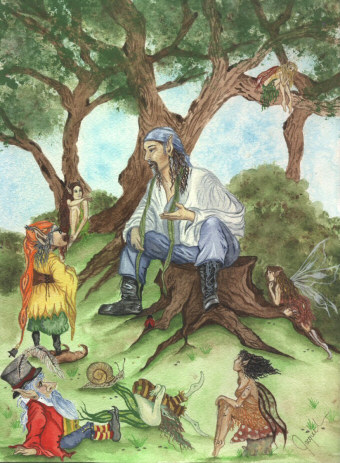
". . . to further our kinship relationship with the instinctual nature, it assists greatly if we understand stories as though we are inside them, rather than as though they are outside of us. We enter into a story through the door of inner hearing. The spoken story touches the auditory nerve, which runs across the floor of the skull into brainstem just below the pons. There, auditory impulses are relayed upward to consciousness or else, it is said, to the soul . . . depending on the attitude with which one listens.
Ancient dissectionists spoke of the auditory nerve being divided into three or more pathways deep in the brain. They surmised that the ear was meant, therefore, to hear at three different levels. One pathway was said to hear the mundane conversations of the world. A second pathway apprehended learning and art. And the third pathway existed so the soul itself might hear guidance and gain knowledge while here on earth."
Listen then with soul-hearing . . . for that is the mission of story.
~Clarissa Pinkola Estés, Ph.D~
Women Who Run With the Wolves: Myths and Stories of the Wild Woman Archetype
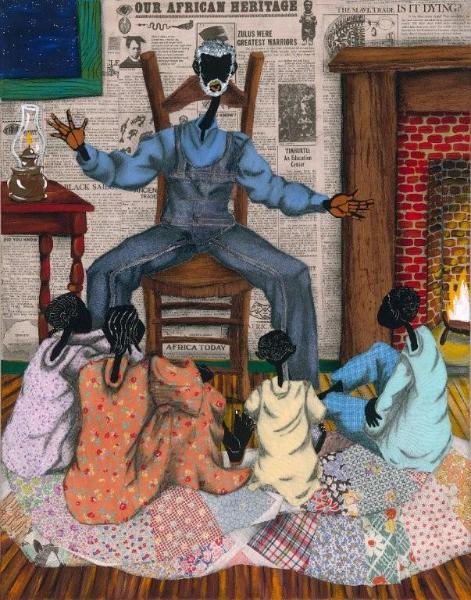 |
|
Why The Bat Sits Upside Down
| 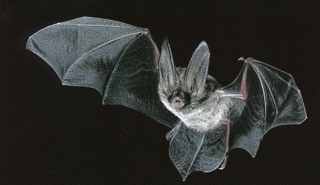 Grandfather knew every story ever told or even heard of in the tribe. And at his age he looked as if storytelling was the only thing he could still do with success. He utilized this talent very well since that was the only way he could gain attention. Each time I sat in his lap, he took it as a request for a story, and he would always begin by asking a question. "Brother Malidoma, do you know why the bat sits upside down?" "No, Why?" "Long, long time ago, and I mean long when I say long because that was when animals used to speak to men and men to animals and both to God." "Then why don't animals speak to men anymore?" "They still do, only we have forgotten how to comprehend them!" "What happened?" "Never mind. We're talking about bats, and why they all sit up-side down." "Yes. I want to know why they do that." "Well, see, there was a time when Brother Bat died and no one knew who he was. The town crier took his body to the crocodile, saying, 'The jaws of this damn thing look like they were borrowed from a crocodile. I thought he might be your relative or something.' "The crocodile said, 'It's true that this guy's got a mouth like mine, but I ain't got no brother with fur, let alone wings.' "So next the town crier took the dead bat to the head of the birds tribe." "And who's that?" "It's Mother Sila, you know, the bird that flies high and shoots herself down like an arrow when she goes to catch her dinner. Mother Sila said, 'This animal looks like it's got wings and reasonable claws, but I never saw anyone in my family with so few feathers.' "And so, finally the town crier gave up and threw the bat into a ditch. But when Papa Bat found out about this, he was very angry. He rebelled against God and ordered the whole tribe never to look up to God again. Since then bats never turn their faces upward. "Grandfather, this is too sad. Tell me another one." Grandfather never had to be begged. He would tell you a story even without you asking. And the times you asked, he would keep on talking until you "unasked" him. Of Water and the Spirit pgs. 21-22 ________________________________________________ ________________________________________________ REFLECTION: Where are you in this story and why? |
Mythology and Dagara Cosmology
By Glenn Leisching
|  "A life without purpose is an unfulfilled life," Malidoma says. Like Malidoma, Joseph Campbell (1904 - 1987), the world's most famous scholar on mythology and fondly remembered for his heartfelt encouragement to "follow your bliss," taught that all myths are birthed from the womb of inspiration and the imagination. Campbell, like Malidoma, encourages Westerners to create new myths that life may be artistically rendered to be more fulfilling and purposeful. 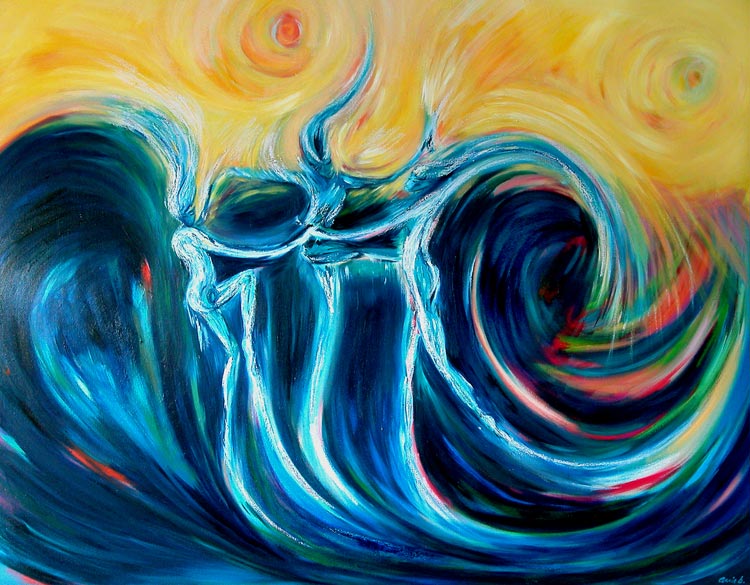 | "Dancing Water Spirits"-- annie b.
|
With a very specific and intended purpose to transcend the ordinary, myths have the power to expand our awareness into 'extra-ordinary' or 'otherworldly' realms which awaken us to the grand potential of the human psyche. Myth has immense power to bring about radical paradigm shifts, Campbell taught, and is limited only by the degree of one's attachment to their literal interpretation. Appreciating and constantly referring to the breakthrough work of Sigmund Freud and Carl Jung, he used the immediacy of dreams as a gateway into mythology. By skillfully connecting the psychology of the dreamer to the reflective, informative and healing nature of dreams, Campbell opens the door to the vast realm of symbolism residing in one's dreamworld. "Myths," he said "are public dreams". Dreams are "private myths." Toward the latter part of his life, Joseph Campbell recognized the need for the creation of new mythologies to empower and inspire new public dreams. Modernity, with its industrial prowess, speed, urbanization, and the resulting predominating emphasis of the rational intellect of pronounced individualism, has become disconnected from mystery and myth. Malidoma, during Indigenous African Spirit Technologies training, says that one's purpose is discovered, is nurtured, and matures in community, for community is the direct beneficiary of one's life purpose. Like Campbell, he underscores that we need myth to realize and expand our conditioned vision of our life purpose.  After the miraculously peaceful revolution in 1994 in South Africa, an unprecedented post-apartheid national healing event occurred. Lead in part by Nelson Mandela and Arch Bishop Desmond Tutu, the nation found themselves within a giant Dagara-like ash circle - the Truth and Reconciliation Commission. The fire of truth and intention was cooled by the water of grief and reconciliation which then birthed into life a new nation. I repeatedly asked myself... "What was the public dream - the myth - that inspired such a radical approach that successfully healed a once pained and shattered country?" Soon the answer arrived...it was the African myth of 'UBUNTU.' In stark contrast to René Descarte's "COGNITO ERGO SUM" (I think, therefore I am) which became a fundamental element in Western philosophy, Ubuntu translates as... "because you are a person I am a person", or "I owe my humanity to your humanity." The spirit of Ubuntu bonds the individual to the community and the community to the individual. It exists throughout Africa under different names and forms. Each person is a gift of healing to the other and a profound reflection of the expansive totality of the individual. Any harm done to the other is harming and limiting of one's relationship with oneself and to the entire universe. It could be said that this African myth, or African public dream of Ubuntu, in the form of Dagara cosmology is brought by Malidoma to the West as a medicinal antidote to the imbalance caused by Descarte's "I think, therefore I am" and the resulting overemphasis on the individual who constantly races and competes to stand apart from community, only to find themselves isolated, depressed and feeling incomplete. I am reminded of a time during Elder Initiation while carrying the life of the village in our hands, when Malidoma directed the initiates to listen to the smell of the Other World. Much later the smell came to me as a cacophony of jingling sounds that reminded me of an ancient African proverb that impressed my then 13 year old mind. The proverb translates as "one bangle cannot jingle." The mythology present in Dagara cosmology is full of poetry, art, healing and expression. It is a musical dream that invites us to dance into existence our full potential as human beings. Indeed, one bangle, alone, cannot jingle. Alone, our gift of unique expression cannot be heard. The living myth of Ubuntu as expressed through Dagara wisdom envelops each of us with a community from which, try as we may, we cannot escape. Our connection to our ancestry, to our life force and emotional realm, to our sense of expression and self confidence, to our authenticity, is connected to this great Earth and her sacred elements. They generously imbues each of us with all we need to perform our vital and essential role in life's constantly unfolding mythological drama. The stage is set. All we have to do is enter. 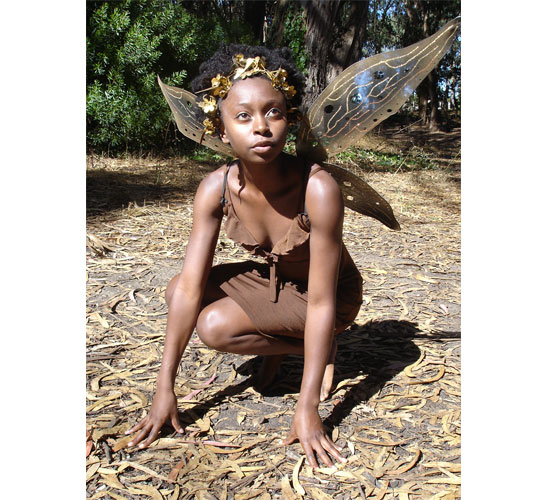 After a session with Malidoma, I eagerly approached him and confidently stated ..."we are each a myth!"... to which he replied... "we are the creators of myth." I walked away stunned! It radically shifted my perspective and changed my life forever. Glenn Leisching can be contacted at: onebanglecannotjingle@gmail.com
|
|
Ask Malidoma!
|  Q: Recently I have felt inspired by spirit to paint! My pictures are of visions from my dreams and journeys with plant spirits. For some time now I have followed the shamanic path of healing but lately have felt that Art is a new pathway I should explore to use as a healing tool. I feel this inspiration comes from the Ancestors. I would appreciate your insight on this. A: The sensory reality of our world is apartness, a kind of division and isolation that makes it easy to classify and compartmentalize. In this context, we people use questionable means to define other people; and sometimes we even prefer to distance ourselves from anything we do not understand out of the fear of losing our identity or having to reconsider our definition of it. There is certainly a reason supporting these positions, as there is a reason why we usually can't see ourselves more at one with Nature and the Earth. However, more often than not, this is what leads to isolationism, insensitivity to what is going on around us and, more importantly, refusal to relate because we do not know what we are relating to and why we should.  | | Igbo Medicine Man |
Is it possible to equate shamanism with art and the shaman with the artist? My answer is: we must. Art is the pursuit of beauty. The healing art, which is the backbone of shamanic practices, is rooted in the pursuit of aesthetic. This is why healing is the rectification of the parameters of aesthetic gone wrong. If the purity of the origin had remained untouched, undamaged and secure, we wouldn't need artists. But none of us was born into a perfect world. Thank God, otherwise we would be bored out of our minds because we would not have very much to do! The exciting thing is that perfection is hidden in the flaws we came to see as intrinsic to this world. Our ancestors sent us into this world to contribute laboriously to the extraction of beauty back into visibility. They expect us to remember and to trust our memories on this fundamental task. How we do this matters less than the fact that we have to do it. Let us not be distracted by mere details.  | | Artist Abdul Badi, Brooklyn NY |
The painter contributes to the healing of the human consciousness. His/her work consists in pulling out from the hidden and into the visual, the transforming pieces of aesthetic nourishing to the human psyche and contributing to the beautification of this world. The shaman is committed to facilitating the homecoming of all living things in the vast concert of the universe where oneness with all that exists heals permanently. Let us admit that such a thing is beautiful. It is this that we feel irresistibly compelled to pursue from the day we were born as if we come into this world already knowing that such a thing exists. This knowing later on translates into a heightened sense of awareness compelling enough to make us respond to sound and rhythm, as if it is a call to action. It is also this awareness that makes others respond emotionally to human needs and human predicament. In this state, the hidden language and sound of the world in need of unity is made loud and clear; and those who feel it and understand it well respond to it the only way they can or know how. The painter shares with the shaman these very things: inner sight and outer sensitivity. They see through the opacity of human limitations. They smell the Other World and crave to instill more magic into this world. They hear the voices of that which needs the touch of human hand to restore stolen sanctity, tarnished beauty and muted magic. They are driven into the Other World to escort back into this world the magic that reawakens the heart rhythm to sacred emotion, the beat of love in response to the sound of beauty. They labor hard to contribute to the monumental cleansing job the world needs for healing. When they do this, the rest of us are reconnected with the Earth Mother, the magic of Mother Nature, the Trees, the Mountains, the Stones and Bones of memory, and with the Ancestors. What else elevates the human divinity more than this? It goes without saying then, that the artist and the shaman belong to the same tribe, the same family and the same fellowship. They both respond to the same prime directive: seek out and heal. They are both dancing to the magical throbs of a world that holds more than meets the eye because they know it. They are aware. In the words of the poet elder William Stafford "It is important that awake people remain awake, for the darkness around us is deep." Ashe!  | | Artist Suzanne Ouedraogo, Burkina Faso |
___________________________________________
____________________________________________________
Many inquiries come to Malidoma through cyberspace concerning a deeper desire to connect with and experience personal, more in-depth knowledge and information of Dagara traditions & cosmology, and their real application for daily modern living. Ask Malidoma! was created as a way to fill that need.
He is eager to respond to questions on Dagara spiritual traditions & cosmology, the elements, nature, divination, ritual & community, inter-dimensional beings & worlds, kontombili, the role & benefit of ritual sacrifice, ritual application for daily living initiation, shrines, ancestors, etc.
Send your question to askMalidoma@gmail.com. Malidoma will choose and respond to at least one question per newsletter. He is most likely to respond to the question with the widest appeal to the community, or the question that is most-frequently asked.
|
|
Dagara Cultural Youth Festival Feb. 21-27, 2011
| |
Accepting Donations
|

| | Photo By Theresa Thomas |
The Dagara Cultural Youth Festival February 2010
was a tremendous success! The monetary support Malidoma received through donations for the festival--without a doubt--played a major role.
Because of this achievement, Malidoma has indisputably become the leader in the safeguarding and promotion of Dagara ancestral traditions. In the past, UNESCO, a division of the United Nations was co-sponsoring this government program. Suddenly in
2009, both UNESCO and the government dropped any support and the Ministry of Culture told Dano that it was
on its own. The High Commissioner of Dano, upon
learning through the grapevine of what Malidoma had
been doing in the West, asked him for help. This was
the beginning of Malidoma's highly visible leadership
role in his own country (he was featured on T.V. several times in Burkina Faso--never before had this occurred).
The Dagara Cultural Youth Festival is an attempt to interest youth in the values of the traditions of their ancestors so that they can preserve it in themselves amidst the sweeping changes of modernity. UNESCO had shown interest in it for reasons of its own and then dropped out when these interests dried up.
Again we need your help!
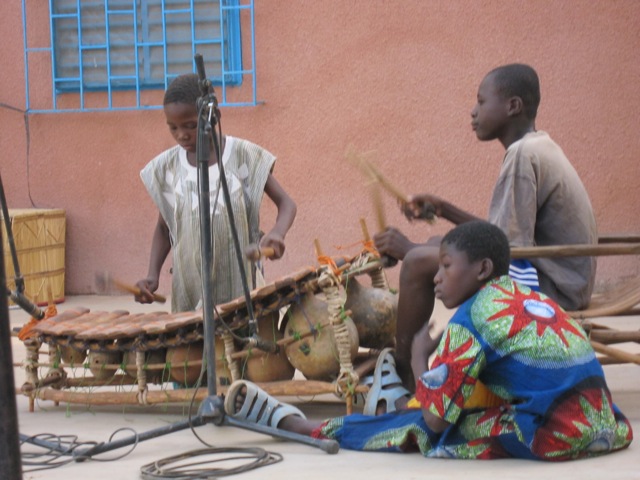 | | Photo By Theresa Thomas |
If you have ever been moved by the values of the Dagara culture in the West, this is a wonderful opportunity and--we believe--an invitation from the ancestors to step up to the plate and show the extent of our appreciation of the wisdom that is now endangered in its place of birth.
The goal is to raise $15K or more for this week-long event. Your tax-deductible contribution can be sent directly to Aviela Inc., c/o Robert Walker, P.O. 82, Cherry Plain, NY 12040. Or go to our website to use PayPal to donate.
Once again this is a call to rise, for it is now time to shine! We truly appreciate your support.
ASHE!
|
Indigenous African Spiritual Technologies (IAST)
March 30th--April 3rd
Ojai, California
| 
Beginning A New, Two-Year Intensive Training Cycle!
"The time for a vigorous devotion to and embracing of the wisdom of indigenous Africa has come. After centuries in silence and hiding, the powers and wisdom of the ancestors are rising up to lead the world into the next level of consciousness and spirituality." -- Malidoma
JOIN US as we begin a new, two-year training
in the spiritual cosmology and technologies of
the Dagara people of West Africa.
The two-year training will be grounded in experiential exploration of the five elements of Dagara cosmology: Fire, Water, Earth, Mineral, and Nature. In this first workshop we will enrich our working relationships with these elements so that we can create, experience, and offer rituals invoking the healing properties of each element, for the benefit of ourselves and others. In subsequent workshops, we will empower and deepen our relationship with the Spirit World through an intensive "Ancestralization" Ritual, followed by creating cowrie shell divination kits and talismans, and we will begin to acquire skills in utilizing these spiritual technologies. Through our time together, we will experience a deepening of our connection with purpose and with Spirit. COST: The energy exchange for the program---which includes meals and rustic accommodations---is $1,100 per session; $5,500 for all five workshops over the course of two years. DEPOSIT: A $550 deposit, due by March 9th, 2011 with Program Application, available from www.temenosofojai.comwill hold your space. Payment may be made by check, cash, or money order. Make your checks payable to Tudor Marinescu. Mail completed application and deposit to: Tudor Marinescu 2128 Pico Blvd Santa Monica, CA 90405 info@temenosofojai.comFull payment is due no later than at registration at each of the sessions. For more information call 805-633-4624 or write to info@temenosofojai.com also see website www.temenosofojai.com |
|
Upcoming Events
| |

Malidoma at Augsburg College, Minneapolis, MN
The Center for Counseling & Health Promotion
2010-11 Convocation Series Presents:
"Water & the Spirit"
Friday, February 11, 2011, 3:30-5 pm
Hoversten Chapel, Foss Center
"The Healing Wisdom of Africa"
Saturday, February 12, 2011, Noon-1 pm
Hoversten Chapel, Foss Center
A booksigning will take place on Friday at 5 pm
and Saturday at 11:30 am in the Arnold Atrium,
Foss Center. All events are free and open to the
public. For more info or special requests, call
612-330-1104, or visit our website.
Private Divinations
Minneapolis, MN
February 13-16, 2011 Write to info@malidoma.com to schedule an appointment.
Dagara Cultural Youth Festival
February 21-27 Dano, Burkina Faso, West Africa
write to info@malidoma.com for details.
Private Divinations
Asheville, NC
March 12-16, 2011
Write to info@AncestralEvents.com to
schedule an appointment.
IAST-4th Session
Santa Rosa, CA
March 23-27, 2011
IAST-1st Session
Ojai, CA
March 30-April 3, 2011
See information above in the body of this newsletter.
Write to info@temenosofojai.com for more information
or call 805-633-4624.
Malidoma @ Revelation Conference & Michael Beckwith
Hyatt Regency Century Plaza Hotel, Los Angeles, CA
for more info, click here
April 14-17, 2011
Private Divinations
Los Angeles, CA
April 18-20, 2011
Public Talk
Washington D.C. Metro Area
(Details will be forthcoming)
April 28, 2011
Healing Relationship with Our Ancestors Ritual Workshop
The Lodge in Berkeley Springs, West Virgina
(Details will be forthcoming)
April 29-May 1, 2011
Private Divinations
Washington D.C. Area
(Details will be forthcoming)
May 3-5, 2011
Private Divinations @ CREATINGSPACE for Women
Park Slope area, Brooklyn, NY
May 12-15, 2011
"Healing w/your Ancestors" African Spirituality & Ritual
Malidoma Somé at Alternatives---Public Lecture
St. James Church
Piccadilly London, England, UK
for more info, write to Richard Pantlin
also for more info see website
May 23, 2011 7pm
"Healing w/your Ancestors" African Spirituality & Ritual
Malidoma Somé in Residential Weekend Workshop
Hawkwood College, near Stroud,
(in the Cotswolds Hills)
Gloucestershire, England, UK
May 28-30, 2011
Cost:
2-night residential workshop with all meals -£385
Additional Friday night with supper -£50
Single room supplement (for 2 or 3 nights) -£50
Deposit with booking (non-refundable) -£190
Early bird disc. for booking rec'd by 2/15/11 -£30
For enquires, booking form, & more info,
write to richardpantlin@yahoo.co.uk
Cheques should be made out to "Hawkwood College."
Malidoma will also be available for private
divinations in the UK. For more info & details
write to richardpantlin@yahoo.co.uk
Ancestralization Ritual: Ancestors, Community, &
the Healing Power of Ritual with Dr. Malidoma Somé
Zen Mountain Monastery
Mt. Tremper, NY
June 8-12
Private Divinations
Chichester, NY
June 14-16, 2011
Healing Relationships with the Ancestors:
Purifying Fire Ritual Weekend Intensive w/Malidoma Somé
Asheville, NC---click this link for more information
June 24-26
Private Divinations
Asheville, NC
June 27-28, 2011
Write to info@AncestralEvents.com to
schedule an appointment.
|
|
|
|
|
|
Malidoma's Pen
| 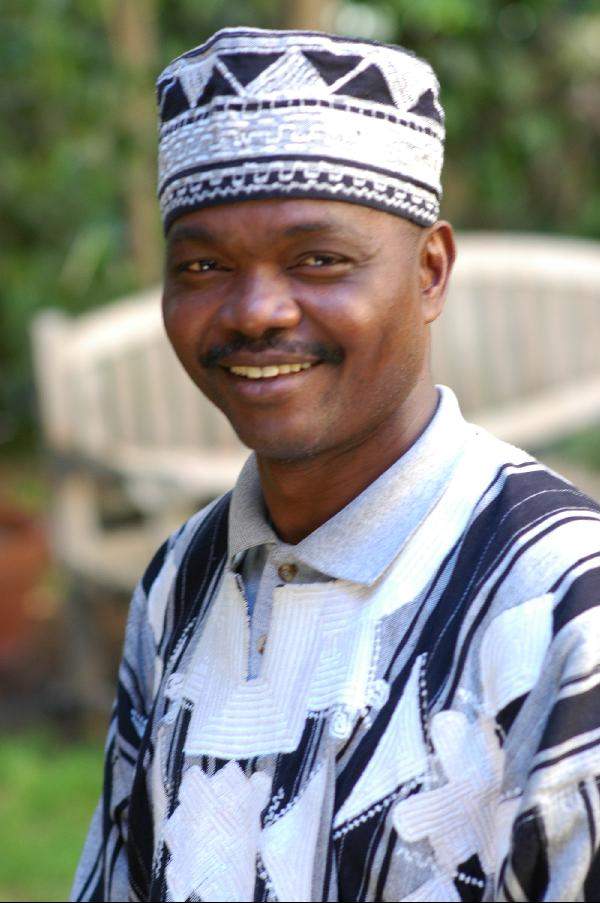 |
"In the village stories are clearly seen as in the domain of the element mineral, holding the
key to memory and purpose. Everyone
must participate
and bathe in mythologies.
Stories are not just for children; they are for
the child in everyone, who remembers and understands. Stories open a world wherein relating to others
and the world
is automatic,
and they boost imagination
toward a place of better self-knowledge. Without stories, a society will find it difficult to hold
itself together.
It is as if stories bond people together and allow each individual to better comprehend what their place is in the world, and how their place holds everything else together. Indigenous teachings are derived from stories that they see as eternal blueprints for human wisdom. Like a forest in which countless beings find their home, stories are places where each one of us can find a home. The home in
the story is the image we hang on to and
identify with.
It represents our address in the city of the story. This home can change from story to story and from one day to the next. This is because as the circumstances of our lives change, so too does the place we inhabit in stories.
In ritual storytelling, the narrative must guide and inspire people. First the story must be chosen to reflect current matters. then someone must tell it in a way that involves every listener, so that everyone finds something to identify with in the story, and
the teller and audience become one. The teller borrows his story from the pool of ancestral lore. As they listen, people must find a place for themselves inside the story. This place will be each person's area of focus as they work to recall their deep identity.
Who we are appears spontaneously within myth if we allow ourselves to be open to it. Each place in
the story is a milestone representing someone, and everyone's position in the story will be more or less different.
At the end of the story, each person should have received some further insight into his or her own purpose or position. Such clarity indicates an ability to locate oneself even in the middle of chaos and confusion. It is as if confusion and dissatisfaction are the psyche's way of telling us that we're not where we're supposed to be. Clarity about one's position is essential to our sense of identity and important for healing because ritual storytelling can be of great value in helping people locate themselves in society and in the world."
The Healing Wisdom
of Africa
pgs. 250-251
|
|
Prayer & Song
|  | |
K'a te sankun koro siun a ti tièru
ti kuti zumon.
Ka it tuon gnin a tivla zié ti tisau déu.
"May all ancestors join forces to wake up our spirit and put good thoughts into our psyche. Then we shall see the good that awaits us and accept it."
*****************
~Dagara Prayer~
Of Water and the Spirit
pg. 313
____________________
____________________
Dagara Song of Praise to the Ancestors
Puor-ah Sâan minè
Puor-ah Sâan minè
Puor-ah Sâan minè oohh
Puor-ah Sâan minè oohh
Ahhh!
Puor-ah Mâa minè
Puor-ah Mâa minè
Puor-ah Mâa minè oohh
Puor-ah Mâa minè oohh
Ahhh!
Praise to the Great Grandfathers! Praise to the Great Grandmothers!
____________________
____________________
May the spirits of every pertinent direction take notice of their hearts' desire.
May the forces below pump strength into their feet-that they walk the walk of their life, the walk that heals the wounded truth of their bellies and keeps the eyes of their memory open so they can grow
ni yang maru.
May the ancestral fuel burn in their spiritual veins and animate their souls with vision so they can hold hands
ni yang maru.
As they walk toward the future, may they wake up fast to the dialogue between the soul and the spirit.
And may they labor to clean the world from its paralyzing epidemic of soul-barrenness so that tomorrow our children can sing together in peace!
*****************
~Dagara prayer to the ancestors on behalf of those seeking to recover themselves from the rubble of modernity.~
Ritual: Power, Healing, and Community
pg. 103
____________________
____________________
My little family I
leave today.
My great Family
I meet tomorrow.
Father, don't worry, I shall come back,
Mother don't cry,
I am a man.
As the sun rises
and the sun sets,
My body into them
shall melt,
And one with you
and them,
Forever and ever
I shall be . . .
. . .To become a man
I must go,
Into Nature's womb
I must return,
But when I come back,
The joy of rebirth
for you I will sing.
My little family I
leave today.
My great Family
I meet tomorrow.
Father, don't worry, I shall come back,
Mother, don't cry,
I am a man.
*****************
~Walking into the "belly of the bush," this song is sung by male candidates participating in
initiation--Baor~

Of Water and the Spirit
pgs. 193-194
____________________
____________________
I had a date in the bush with all the gods,
so I went.
I had a date in the bush with all the trees,
so I went.
I had a date
in the mountain
with the Kontomblé.
I went because
I had to go.
I had to go away to learn how to know.
I had to go away
to learn
how to grow.
I had to go away
to learn
how to stay here.
So I went and
knocked at doors,
locked in front of me.
I craved to enter.
Oh, little did I know,
the doors did not
lead to outside.
It was all in me.
I was the room
and the door.
It was all in me.
I just had to remember.
And I learned that I lived
always and everywhere.
I learned that
I knew everything,
only I had forgotten.
I learned that I grew,
only I had
overlooked things.
Now I am back, remembering.
I want to be what
I know I am,
and take the road we always forget to take.
Because I heard
the smell
of the things forgotten
And my belly was touched.*
That's why I had a date with the bush.
That's why I had a date with the hill.
That's why I had a date with the world Under.
Now, Father, I'll take
you home.
I am back!
*In Dagara you "hear" smell, you don't smell something. That which is picked up by the olfactory sense is sound being heard in that way. The same thing applies to the tactile. But you can both hear and see taste.
*****************
~Song sung by successful candidates of Baor, returning home~
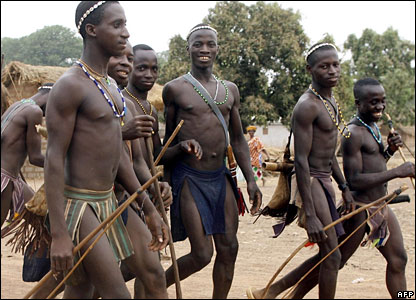 Of Water and the Spirit Of Water and the Spirit
pgs. 295-297
____________________
____________________
Ka ti sankun koro na gan a tinso
tuon kuti laonta yanmaro
Ka u zin a ti sukie puo
ti ya ka ti nonon ta ti yanon ta.
May those from under our feet breathe the warmth of community unto us so that the peace we seek mounts our bodies and sits on the chairs of our hearts, sprinkling love and joy around us all.
***************** ~Prayer of the African Medicine Man Kounbaterzié ´Dabiré ´Guinan~ The Healing Wisdom
of Africa pgs. 17-18 ____________________ ____________________ The blind man
had two eyes, that saw things
that moved and things that
did not move. He thought he
was not blind, and was proud to see, but when asked
to see the moving, in the thing that
does not move, he decided he
was blind. His eyes would
not believe, that the still was not still and that the moving could cease because the only thing the moving knew, was move, move,
and move. Seeing has
become blindness, and that which
does not move, knows you lie to yourself when you lend trust to what you see now. ***************** ~An old Dagara healing melody sung by one of the elders to help Malidoma with his 1st assignment "to see" during his initiation.~ Regarding this song, Malidoma writes in
Of Water and the Spirit, "I listened to the elder sing his mournful song over and over, and it made my body react in strange ways. Instead of hearing the song in a normal way with my ears, I felt instead as if I were hearing it in my body, my bones, my blood, my cells. With each repetition, the meaning of the song seemed different and more helpful to me in some way." Of Water and the Spirit pgs. 207-208 ____________________ ____________________
Invocation to a Fire Ritual 
"O ancestors, we humbly ask that you join us today as we face this uncertain task of burning up the things that keep us from experiencing true communion with you. Please make use of our arms that they may perform the right gestures. Take over our eyes that they may look where you order them to look, and see what needs to be seen. Enter into our feet that they may walk at the right pace on the journey to healing. Take over our bodies that they may bow to the healing you're
bringing to us."
The Healing Wisdom of Africa pg. 153
|
|
Celebrating
Black
History Month with
Poetry
|  | |
History of
My People
by Walter Dean Myers
My eyes touch,
my fingers trace
the griot chants, clicks, songs of the Ancestors.
The warrior words stretched taut across
the soul, drum words whispering the name of God.
They say that beyond the blood-tide cries,
there is triumph!
They say that beyond the blues-moan, there is continuance,
triumph and
continuance,
a reaching back and a forward surge,
a place where Black dreams swell consciousness.
Even as the Niger
swells old seasons into new life.
____________________
____________________
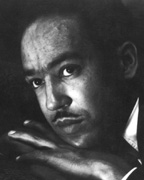
The Negro Speaks
of Rivers
by Langston Hughes I've know rivers: I've know rivers ancient as the world and older than the flow of human blood in human veins. My soul has grown deep like the rivers. I bathed in the Euphrates when dawns were young. I built my hut near the Congo and it lulled me to sleep. I looked upon the Nile and raised the pyramids above it. I heard the singing of the Mississippi when Abe Lincoln went down to New Orleans, and I've seen its muddy bosom turn all golden in the sunset. I've know rivers: Ancient, dusky rivers. My soul has grown deep like the rivers. (Click on the link below to hear Langston Hughes read his own poem and listen to how he came to write it.)
Langston Hughes Reading
____________________ ____________________
The Day
Duke Raised:
May 24th, 1974 By Quincy Troupe 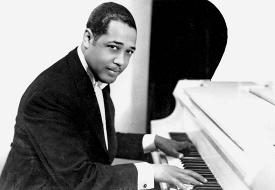
For Duke Ellington 1. that day began with a shower of darkness, calling lightning rains home to stone language of thunderclaps, shattering, the high blue, elegance, of space & time, where a broken-down, riderless, horse with frayed wings rode a sheer bone sunbeam road, down into the clouds. 2. spoke wheels of lightning jagged around the hours, & spun high up above those clouds, duke wheeled his chariot of piano keys, his spirit, now, levitated from flesh & hovering over the music of most high, spoke to the silence of a griot-shaman-man who knew the wisdom of God. 3. at high noon, the sun cracked through the darkness, like a rifle shot grew a beard of clouds on its livid, bald face, hung down, noon, sky high pivotal time of the flood-deep hours, as duke was pivotal, being a five in the nine numbers of numerology as his music was one of the crossroads, a cosmic mirror of rhythmic gri-gri 4. so get on up & fly away duke, bebop slant & fade on in, strut, dance swing, riff & float & stroke those tickling, gri-gri keys, those satin ladies taking the A-train up to harlem, those gri-gri keys of birmingham, breakdown sophisticated ladies, mood indigo. Get on up & strut across, gri-gri raise on up, your band's waiting. 5. thunder-clapping music, somersaulting, clouds, racing across the deep, blue wisdom of God, listen, it is time for your intro, duke into that other place, where the all-time great band is waiting for your intro, duke it is time for the Sacred Concert, duke it is time to make the music of God, duke we are listening for your intro, duke so let the sacred music, begin! (Hear an audio clip of the poet Quincy Troupe reading his poem here) ____________________ ____________________ Harriet Tubman by Eloise Greenfield 
Harriet Tubman didn't take no stuff Wasn't scared of nothing neither Didn't come in this world to be no slave And wasn't going to stay one either "Farewell!" she sang to her friends one night She was mighty sad to leave 'em But she ran away that dark, hot night Ran looking for her freedom She ran to the woods and she ran through the woods With the slave catchers right behind her And she kept on going till she got to the North Where those mean men couldn't find her Nineteen times she went back South To get three hundred others She ran for her freedom nineteen times To save Black sisters and brothers Harriet Tubman didn't take no stuff Wasn't scared of nothing neither Didn't come in this world to be no slave And didn't stay one either And didn't stay one either ____________________ ____________________ Notebook of a Return to a
Native Land by Aimé Césaire 
....My negritude is not a stone, its deafness hurled against the clamor of the day My negritude is not a leukoma of dead liquid over the earth's dead eye My negritude is neither tower nor cathedral it takes root in the red flesh soil it takes root in the ardent flesh of the sky it breaks through opaque prostration with its upright patience. Eia for the royal Cailcedra! Eia for those who never invented anything for those who never explored anything for those who never conquered anything but yield, captivated, to the essence of things ignorant of surfaces but captivated by the motion of all things indifferent to conquering, but playing the game of the world. Truly the eldest sons of the world porous to all the breathing of the world fraternal locus for all the breathing of the world drainless channel for all the water of the world spark of the sacred fire of the world flesh of the world's flesh pulsating with the very motion of the world! Tepid dawn of ancestral virtues Blood! Blood! All our blood aroused by the male heart of the sun those who know the femininity of the moon's oily body the reconciled exultation of antelope and star those whose survival travels in the germination of grass! Eia perect circle of the world, enclosed concordance! Hear the white world horribly weary from its immense efforts its stiff joints crack under the hard stars its blue steel rigidities pierce the mystic flesh bear its deceptive victories, tout its defeats hear the grandiose alibis of its pitiful stumbling Pity for our omniscient and naive conquerors! Eia for those who never invented anything for those who never explored anything for those who never conquered anything Eia for joy Eia for love Eia for grief and its udders of reincarnated tears. And here at the end of this daybreak my virile prayer, that I hear neither the laughter nor the screams, my eyes fixed on this town which I prophesy, beautiful, grant me the savage faith of the sorcerer grant my hands the power to mold grant my soul the sword's temper I wont flinch. Make my head into a figurehead and as for me, my heart, do not make me into a father not a brother nor a son, but into the father, the brother, the son, nor a husband, but the lover of this unique people. Make me resist any vanity, but espouse its genius as the fist the extended arm! Make me a steward of its blood make me a trustee of its resentment make me into a man for the ending make me into a man for the beginning make me into a man of meditation but also make me into a man of germination make me into the executor of these lofty works the time has come to gird one's loins like a brave man-- ____________________ ____________________ Immortality by Men Maa Aim Ra be ever present like the blackness of night what about the light of day you ask i reply with the brightest sun comes the darkest shadows 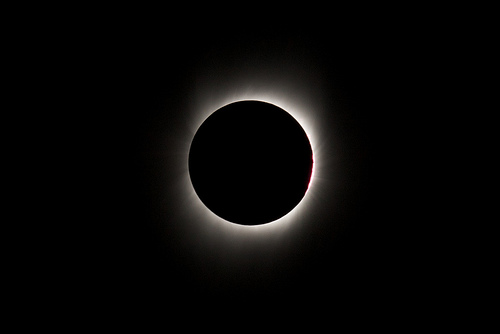 |
|
|
|
|
"Stories set the inner life in motion, and this is particularly important where the inner life is frightened, wedged, or cornered. Story greases the hoists and pulleys, it causes adrenaline to surge, shows us the way out, down, or up, and for our trouble, cuts for us fine wide doors in previously blank walls, openings that lead to the dreamland, that lead to love and learning, that lead us back to our own real lives...."
~Clarissa Pinkola Estés, Ph.D~ Women Who Run With the Wolves: Myths and Stories of the Wild Woman Archetype 
|
|
|
|